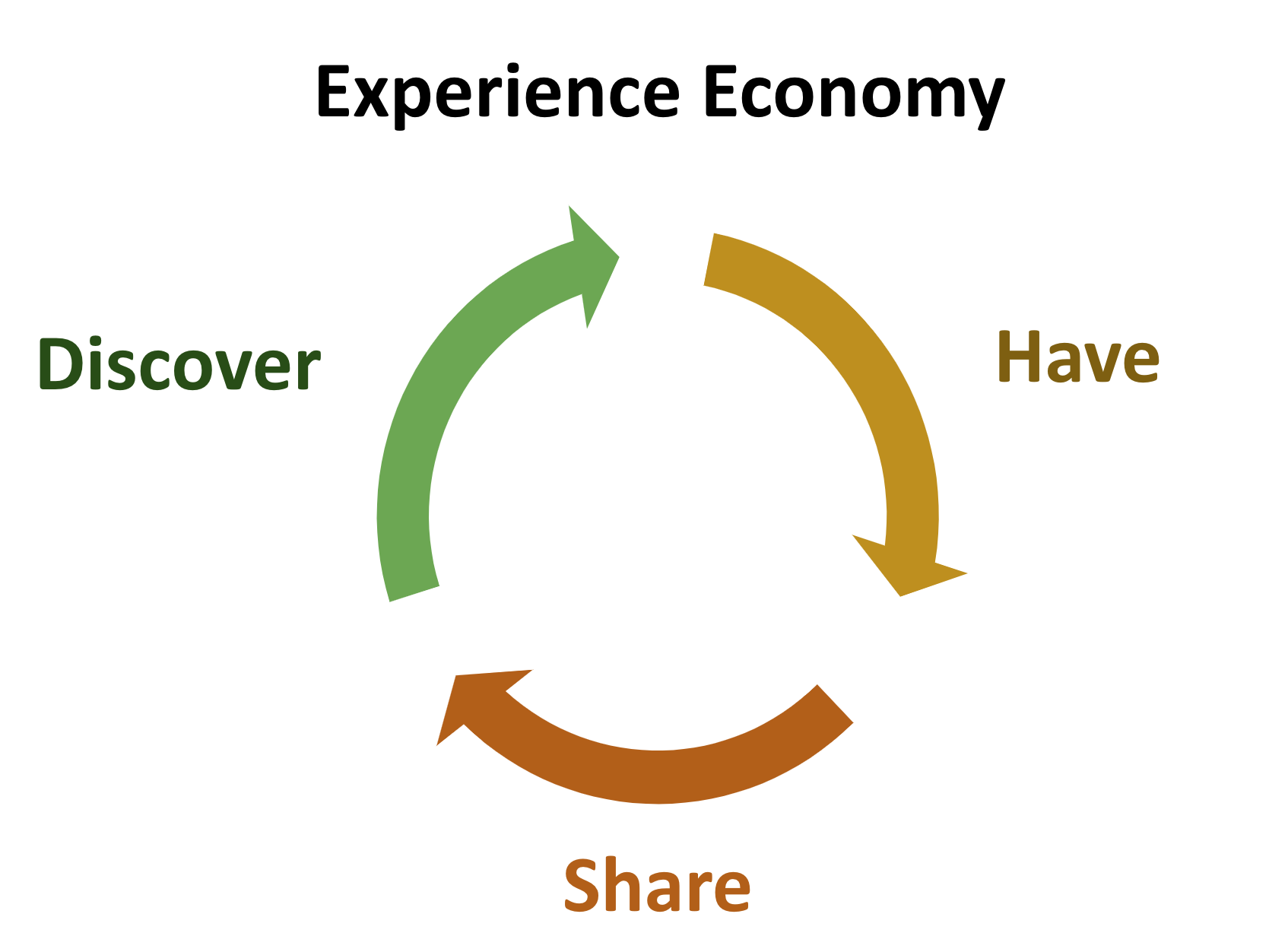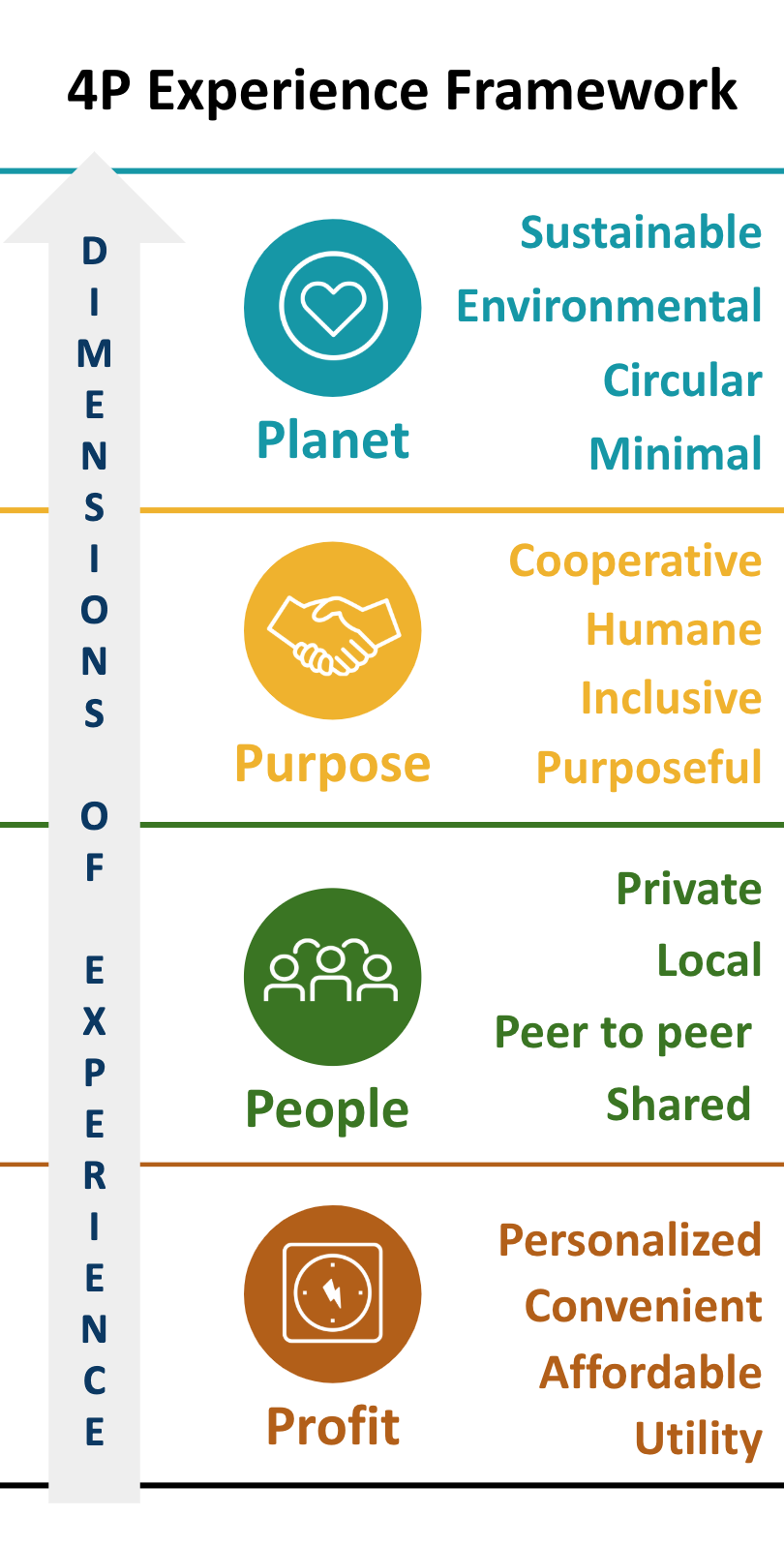From Products to Experiences

According to the US Bureau of Economic Analysis and McKinsey, the US has witnessed a tectonic shift in spending over the past few years with 4x more spending devoted to experiences rather than physical goods.1 This phenomenon was first described by B. Joseph Pine II and James H. Gilmore, who referred to the experience economy as the next economy following the agrarian economy, the industrial economy, and the most recent service economy. Pine and Gilmore argued that businesses must orchestrate memorable events for their customers, and that memory itself becomes the product, also called the “experience”2. This shift toward discovering, having and sharing experiences is illustrated by the circular process in Figure 1. Now, hitech platform companies like Alibaba and Tencent (WeChat); that recognize experiences span multiple companies and industries; are enriching their retail and social platforms with cross-industry services which enable them to own and monetize all facets of a consumer’s experiences throughout life3. This aggregation of products around the facets of a consumer’s life, ( i.e. selling “life experiences”) makes memorable experiences convenient to buy and share. As this phenomenon accelerates, the advantage goes to platform businesses like Alibaba and Tencent whose personalization algorithms already command the attention of billions of consumers. We can’t help but think Facebook, Amazon and Google will soon follow their lead.
Transcending the personalization algorithm – a global imperative
The shift toward fewer and fewer high-tech platforms that dominate the experience economy creates an existential threat for any business that operates “below the personalization algorithm”. We see two ways that businesses can keep pace with or surpass this market dynamic. Businesses can co-create open platform cooperatives as alternatives to the dominant platforms and/or incorporate new dimensions to experiences that resonate with consumers and that no single platform can provide. As we will demonstrate below, this cooperative approach to creating multi-dimensional experiences opens up new opportunities for business and aligns with rapidly emerging consumer preferences.
Multi-dimensional experiences

While convenience is what most people expect, younger generations increasingly care about other aspects of experiences. What are they valuing more? To answer that, we turned to behavioral psychology. Using a framework similar to Maslow’s hierarchy, we developed our 4P framework which depicts four dimensions of experience – one that focuses on what consumers expect – convenience and three that go beyond that to depict what younger generations value most – the social aspects of experiences. Collectively, these four dimensions comprise the opportunity for cooperative ecosystems to co-create new multi-dimensional life experiences. Let’s illustrate the framework with an experience we all share – eating.
Profit
The profit dimension is largely about cost and convenience and involves assembling an experience from which people benefit or “profit”. Eating involves multiple providers and industries representing separate facets of our lives. Providers from the agriculture, consumer goods, grocery, nutrition, delivery, real estate (events), publishers (recipes), social media (recommendations), and entertainment industries all potentially play a role in eating. Some components are aggregated for us in supply chains while others we must put together. The more components assembled for us in a convenient, cost effective and personalized way, the more we benefit or “profit.”
People
The people dimension is about feeling connected to others – people you’re eating with, your social media friends, and the community in which you live. A great meal is better shared with friends, physically and virtually. People use social media before (recommendations), during (live stream) and after (vlog, photos) an experience. Meals from local providers would also be valuable since they support the local community. It’s all about connection and community. The profit and people dimensions are responsible for the emergence of the aforementioned life experience aggregators who combine convenience and connection to cater to emerging consumer preferences.
Purpose
The purpose and planet dimensions are heavily influenced by millennials. Recent studies show that “more than 9 in 10 millennials would switch brands to one associated with a cause,” and that millennials are “prepared to make personal sacrifices to make an impact on issues they care about.” This dimension recognizes that people care about the impact their buying decisions have on larger societal issues such as economic inclusion and human rights. In this dimension, people care whether a meal is sourced from an economically inclusive farm cooperative or from providers with transparent and humane working conditions.
Planet
The planet dimension is about the impact an experience has on the environment and planet. In this dimension, people value transparency about whether a meal is created sustainably – for example, using sustainable agricultural practices, minimizing carbon emissions, and reducing waste through a circular supply chain. The more transparent and socially oriented experiences become (i.e. – purpose and planet), the more they require cooperation to create. As we transition toward these experiences, blockchain is poised to enable a revolutionary new infrastructure for global transparency and cooperation.
How Blockchain Enables Multi-Dimensional Life Experiences
Two aspects of blockchain technology are crucial for cooperative ecosystems to create multi-dimensional experiences: 1) it creates a level of business transparency not historically common in the private sector and 2) it enables open cooperation across private, public and social sectors of the economy.
Both aspects of blockchain make our eating experience example more purposeful. For example, value creators like farmers often have little power over the global food system and barely make a living. A blockchain cooperative model can distribute decision making and ownership more equitably to value creating participants with voting tools and automate agreed upon rules and contribution-based payments in a way that’s open and transparent to consumers.
These blockchain attributes also support planet-conscious experiences. Consider geographies with year-round growing seasons. Creating an optimally sustainable local food system would require landowners; farmers; agricultural businesses; regulators; public utility providers and experts to collaborate across boundaries that aren’t often crossed today. Crossing these boundaries makes it possible to optimize things like arable land in a community, whether it’s owned by individuals, government, or businesses. Cross-sector ecosystems require incentives to focus activities across disparate organizations. Blockchain can create this with a common incentive layer governed by smart contracts that align all participants to a common goal. For participants to earn these incentives, they would need to submit data verifying their actions. This verification data could also be shared with consumers to prove that an experience was created in a planet-conscious way.
Finally, blockchain can enable platform cooperatives that create a marketplace amenable for multi-dimensional experiences. Here the rules of platform engagement would be collectively decided to best support the participants’ needs. This is an opportunity for organizations interested in competing with the tech giants of today, but along different dimensions of value that consumers increasingly want in their experiences.
Conclusion:
The new role of business in community
As we’ve shown above, consumers care about experiences that align with an ever increasingly multi-dimensional set of values. They want experiences that are convenient, connected, socially conscious and sustainable. This shift toward the social aspects of experience represents an enormous business opportunity for those who create value in cooperative ways. As more consumers favor multi-dimensional experiences, businesses whose strategies embrace co-creating social experiences in ecosystems will create a collaborative advantage over those who operate autonomously and focus solely on personalization and convenience. While business has historically treated the economic and social aspects of our lives as separate, rarely integrating profit making and corporate social responsibility initiatives, there is opportunity to move beyond this “take and give back” paradigm to redefine business as the creation of value in context of community. Jamsetji Tata, founder of the Tata group, famously noted that the purpose of business is to serve community. Blockchain’s unique capabilities make that more possible now than ever. Blockchain creates a new paradigm where profit making and purpose serving activities become synonymous, where corporations leverage ecosystems to grow their business and ecosystems leverage business to serve their purpose. In this symbiotic relationship, a corporation’s livelihood will depend on its reputation within the ecosystems it serves. That reputation will hinge on how compelling its purpose, how openly it collaborates, how transparent its operations, and how sustainable the products it contributes to the ecosystem.
This article was originally published in Consensus 2019 magazine.
